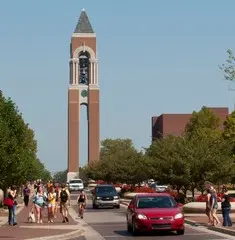The acceptance rate, a percentage of applicants who accepted, is an difficulty indicator for college admission. In general, the lower the acceptance rate, the more difficult it is to get into college.
The top ranked colleges such as
Harvard and
Stanford keep very low rate of less than 10%. A Number of schools has been working to lower their acceptance rate in recent years. For example,
UTK's rate dropped from 78.85% (2019) to 46.00% (2023) and
UVA's rate fell from 23.94% (2019) to 17.00% (2023)
At 22 colleges, the acceptance rate is continually dropped year by year in the past 5 years. A main factor driving down the acceptance rate is the increase in the number of applicants, while the number of admitted students does not change drastically. In fact, many schools had significantly more applicants than last year.
In addition, schools' effort results in the lower acceptance rate. Low rates can be a way to get relatively good students, so schools try to keep them as low as possible. Also, a shrinking number of students or school size can lower acceptance rates.
The next two tables show the key statistics and the changes of acceptance rate for the past 5 years. You can check the detailed information and admission trends in each school's page.
Comparison Table
The following two tables compare the colleges with important academic statistics as well as admission facts. The tuition and admission data is based on the academic year 2023-2024 and enrollment data is based on the academic year 2022-2023
Key Statistics
| School Name | Acceptance Rate | Yield |
Population | SAT Score | Tuition |
|---|
| In-State | Out-of-State |
|---|
The University of Tennessee-Knoxville
Knoxville, TN |
46.00% | 29.00% | 33,805 | 1,260 | $13,484 | $31,974 |
|---|
University of Virginia-Main Campus
Charlottesville, VA |
17.00% | 42.00% | 26,082 | 1,490 | $22,323 | $59,633 |
|---|
Boston College
Chestnut Hill, MA |
16.00% | 41.00% | 15,287 | 1,490 | $67,680 |
|---|
Fairfield University
Fairfield, CT |
45.00% | 21.00% | 6,019 | 1,310 | $56,360 |
|---|
Alabama A & M University
Normal, AL |
66.00% | 19.00% | 6,007 | 940 | $10,024 | $18,634 |
|---|
Merrimack College
North Andover, MA |
74.00% | 11.00% | 5,505 | - | $51,786 |
|---|
Grambling State University
Grambling, LA |
24.00% | 16.01% | 5,058 | 970 | $7,683 | $16,706 |
|---|
University of Indianapolis
Indianapolis, IN |
73.00% | 11.00% | 5,018 | - | $36,136 |
|---|
Wayland Baptist University
Plainview, TX |
54.00% | 25.98% | 2,978 | - | $23,186 |
|---|
Morehouse College
Atlanta, GA |
51.00% | 24.01% | 2,567 | - | $31,725 |
|---|
Denison University
Granville, OH |
17.00% | 26.02% | 2,416 | 1,380 | $64,000 |
|---|
Spring Arbor University
Spring Arbor, MI |
37.01% | 18.04% | 2,396 | 1,060 | $32,580 |
|---|
Pennsylvania College of Health Sciences
Lancaster, PA |
43.90% | 46.97% | 1,775 | - | $31,866 |
|---|
Hillsdale College
Hillsdale, MI |
20.99% | 62.03% | 1,678 | 1,425 | $32,092 |
|---|
Centre College
Danville, KY |
54.00% | 21.01% | 1,357 | 1,320 | $50,550 |
|---|
Westminster University
Salt Lake City, UT |
68.98% | 12.99% | 1,280 | 1,245 | $41,416 |
|---|
Rochester University
Rochester Hills, MI |
65.10% | 43.89% | 1,167 | - | $27,938 |
|---|
Clarke University
Dubuque, IA |
67.99% | 9.00% | 965 | 980 | $39,600 |
|---|
Bethany Lutheran College
Mankato, MN |
50.96% | 42.09% | 830 | 1,110 | $30,010 |
|---|
Bethany College
Bethany, WV |
60.00% | 16.02% | 623 | - | $34,126 |
|---|
Indiana Wellness College
Carmel, IN |
60.29% | 34.15% | 190 | - | $14,665 |
|---|
Academy of Interactive Entertainment
Seattle, WA |
65.00% | 52.14% | 65 | - | $24,600 |
|---|
Acceptance Rate Changes
| School Name | Rate Change
2020-2024 | 2020 | 2021 | 2022 | 2023 | 2024 |
|---|
The University of Tennessee-Knoxville
Knoxville, TN |
-32.85 | 78.85% | 78.15% | 75.00% | 68.00% | 46.00% |
|---|
University of Virginia-Main Campus
Charlottesville, VA |
-6.94 | 23.94% | 22.58% | 21.00% | 19.00% | 17.00% |
|---|
Boston College
Chestnut Hill, MA |
-11.22 | 27.22% | 26.38% | 19.00% | 17.00% | 16.00% |
|---|
Fairfield University
Fairfield, CT |
-12.13 | 57.13% | 56.13% | 56.00% | 52.00% | 45.00% |
|---|
Alabama A & M University
Normal, AL |
-25.75 | 91.75% | 89.65% | 72.00% | 68.00% | 66.00% |
|---|
Merrimack College
North Andover, MA |
-7.9 | 81.90% | 81.64% | 80.00% | 75.00% | 74.00% |
|---|
Grambling State University
Grambling, LA |
-73.23 | 97.23% | 93.22% | 72.01% | 42.00% | 24.00% |
|---|
University of Indianapolis
Indianapolis, IN |
-19.79 | 92.79% | 84.48% | 78.00% | 76.00% | 73.00% |
|---|
Wayland Baptist University
Plainview, TX |
-43.48 | 97.48% | 81.44% | 81.04% | 70.02% | 54.00% |
|---|
Morehouse College
Atlanta, GA |
-48.8 | 99.80% | 77.07% | 65.00% | 60.01% | 51.00% |
|---|
Denison University
Granville, OH |
-12.39 | 29.39% | 28.17% | 28.00% | 22.00% | 17.00% |
|---|
Spring Arbor University
Spring Arbor, MI |
-28.65 | 65.66% | 63.30% | 60.00% | 47.02% | 37.01% |
|---|
Pennsylvania College of Health Sciences
Lancaster, PA |
-34.34 | 78.24% | 54.19% | 49.09% | 46.04% | 43.90% |
|---|
Hillsdale College
Hillsdale, MI |
-27.28 | 48.27% | 36.48% | 24.01% | 21.01% | 20.99% |
|---|
Centre College
Danville, KY |
-22.44 | 76.44% | 72.08% | 68.02% | 63.00% | 54.00% |
|---|
Westminster University
Salt Lake City, UT |
-22.86 | 91.84% | 87.45% | 75.99% | 70.02% | 68.98% |
|---|
Rochester University
Rochester Hills, MI |
-34.9 | 100.00% | 99.43% | 97.93% | 71.04% | 65.10% |
|---|
Clarke University
Dubuque, IA |
-25.86 | 93.85% | 89.20% | 88.98% | 84.99% | 67.99% |
|---|
Bethany Lutheran College
Mankato, MN |
-21.68 | 72.64% | 64.51% | 61.06% | 58.05% | 50.96% |
|---|
Bethany College
Bethany, WV |
-35.3 | 95.30% | 91.84% | 73.99% | 64.99% | 60.00% |
|---|
Indiana Wellness College
Carmel, IN |
-24.96 | 85.25% | 78.29% | 65.08% | 62.76% | 60.29% |
|---|
Academy of Interactive Entertainment
Seattle, WA |
-27.31 | 92.31% | 91.67% | 82.26% | 79.84% | 65.00% |
|---|








